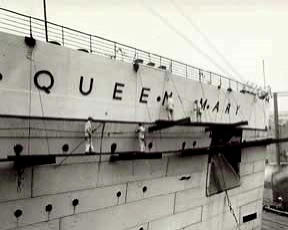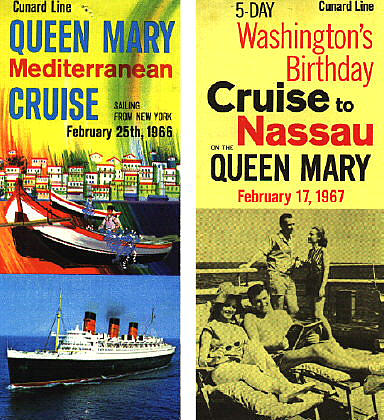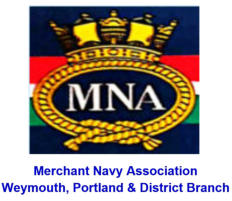



HISTORIC SHIPS
Cunard Line
R.M.S. Queen Mary
RMS Queen Mary was and is one of the grandest Passenger liners ever built. This giant of the sea offered luxury and a standard
unequalled in shipbuilding history. During her remarkable career, from her maiden voyage in 1936 until this day, Queen Mary has
played various roles, from an elegant Ocean Liner, to a WWII trooper, then after 1001 Atlantic crossings, RMS Queen Mary was
preserved and became a fine hotel and tourist facility in Long Beach California.
These pages will bring back happy memories for all who had the pleasure of sailing on her be it as a passenger or a member of the
crew, as well as all those who stood dockside amazed by her grandeur.
“Queen M” Emerges
The building of hull # 534
RMS Queen Mary was conceived in the late 1920’s and she was the first of a pair of ships that was intended to provide a weekly
service between Southampton and New York. Ten years later, in December 1930, construction finally began at the John Brown
shipyard in Clydebank, Scotland on what was known as Hull number 534. However, a year later, on 11 December 1931
construction was halted due to a worldwide economic crisis, a time we all know as the “Great Depression.”
One of her giant screws await fitting
Work has recommenced
Hull 534 languished until 3 April 1934, when due to a combination of a government subsidy and a merger of the Cunard and
White Star Line made it possible for construction to restart in earnest.
Then came the day everyone was waiting for, on 26 September 1934, this huge ship was launched in the presence of His Majesty,
King George V, and his consort, Queen Mary. The public were overjoyed to learn that the Queen officially permitted her name to be
used on this grand liner.
HRH King George V and Queen Mary at the launching ceremony
RMS Queen Mary slowly slides down the slipway
She finally enters the water
A White Star poster
RMS Queen Mary historic maiden voyage to New York commenced on Wednesday 27 May 1936. She departed fully laden as
bookings had been sold out long in advance. Apparently the passenger list read like a page from the “Who’s Who.” First class
passengers included knights, ladies, dignitaries, and certain famous artists. During her maiden voyage there were even two
stowaways found, they were retained and returned to Southampton to face justice, but at least they sailed on the great Queen
Mary!
RMS Queen Mary exuded the elegance of a luxury hotel, housing all the necessities to live a life full of style, fine dinning and the
best of company. In addition to the multitude of Lounges and Bars, there were also were two chapels, a synagogue, a hospital,
nurseries, and several children’s playrooms. A travel Bureau had been located onboard for passengers to make hotel reservations
before their arrival at their final destination.
It would be precisely four days, 12 hours and 24 minutes that Queen Mary’s maiden voyage concluded, arriving amid the kind of
reception only New York could generate. The harbour was filled with an awaiting armada of boats and fire tugs with their water
spouts, in addition thousands of well-wishers that lined the shore. Her maiden voyage had a total compliment of 1,849 passengers
and 1,186 officers and crew, thus she carried 3,035 souls across the Atlantic on her first voyage.
Another Queen Mary departure from the UK – circa 1939
During 1936 to 1939, Queen Mary enjoyed great popularity being the flagship of the great Cunard Line, which had now joined with
the White Star Line. At her launch in 1934, King George V dubbed her as the “Stateliest ship afloat.” However, many testified that
life aboard the newest and fastest North Atlantic liner was anything but staid, for it was well known that her five bars located on
Promenade Deck alone were filled with revellers most of the day and night. Evenings were very much a gala affair with first class
passengers were dressed and frequently looked more like if they were at an event at a Palace. Dinners were always formal
eveningwear. Cabin class (or 2
nd
) was equally well presented, whilst Tourist class (or 3
rd
) had a more casual atmosphere. However,
no matter the class, for each passenger on a voyage on the Queen Mary, it was an event!
A Queen at War
Queen Mary was dubbed the Grey Ghost, due to her great
speed enabling her to evading enemy ships and submarines
As the Queen Mary departed Southampton on August 30, 1939, sailing via Cherbourg France bound for New York. However, little
did anyone know that this would be the great Queen’s last peacetime voyage, for the very next day the Nazis invaded Poland. On
the 31
st
the captain was informed that for security reasons he was to run a zigzag course across the Atlantic and operate under
blackout conditions in order to elude German submarines.
Amongst the celebrities on board were Bob and Delores Hope, although he was travelling solely as a passenger and was not
onboard as an entertainer. It is said that that he continuously made light, even fun of the situation, and that it was not well received,
especially by the British passengers.
Most passengers were very apprehensive for the next four nights as all exterior lights were extinguished, and lookouts were posted
around the ship, and the helmsman continually steering a zigzag course making the ship a difficult a target for a torpedo. After four
worrying nights for her passengers she finally arrived safely in New York on Monday, September 4, and she was laid up awaiting
her orders, which would take another six months.
Then on March 1, 1940, official orders came from the Admiralty calling for the Queen Mary to sail for Sydney Australia where she
would be refitted for war duties. Ten days later on March 21, 1940, Queen Mary departed Hudson Pier New York and steamed
south to South America and then across the Atlantic to South Africa. She refuelled and took on supplies in Cape Town; she then
steamed at a speed of 28 knots across the Indian Ocean to Sydney. Upon arrival, she was handed over to the Cockatoo Docks &
Engineering Company where she was converted for her new role as a trooper.
--The Grey Ghost fully laden with troops
Her luxurious furnishings were removed and replaced by tiers of bunks and hammocks. For protection, a number of small calibre
guns were fitted, however, as it is said, her main protection was her impressive speed.
On May 4, 1940, she left for the Clyde with over 5,000 troops of the Australian Imperial Force on board, arriving on June 16.
Thereafter she headed for Singapore carrying troops due to the Japanese threat of the region. After an overhaul in Singapore, she
returned to Sydney after which she commenced her five-year long trooping duties, during which time she transported over 800,000
troops.
Prime Minister Winston Churchill credited the Queen Mary for shortening the war by as much as a year. At the conclusion of the
war, she continued to transport troops, war brides and their baby’s home until 1946.
Back on the Atlantic
Painting of the two Queens meeting at sea
After completing her wartime duties, Queen Mary was refitted and recommenced her transatlantic service in July of 1947.
However, she had lost the title of “flagship” as she was now joined by her newer and somewhat larger sister, RMS Queen
Elizabeth.
The two Queens were the most successful and profitable ships in the history of the North Atlantic. Both departed Southampton and
New York with a full complement during the 50’s. Passengers had to book many months in advance in order to guarantee a
passage aboard the Queen’s.
The Post-War Years and the Last Voyages.
1958 was a very important year for the Queen Mary, for it was in this year that more people crossed the Atlantic by air than by sea.
The writing was on the wall for the ship but Cunard still tried their best to make her run at a profit. To help reduce costs, her
summer overhaul was omitted. The Mary had lost the Blue Riband to the liner SS United States in 1952, and was therefore no
longer the fastest liner across the Atlantic.
Voyages on the ship could be lonely affairs at these times, especially in winter. In November 1961, the ship carried just 470
passengers on one particular trip, less than one quarter capacity. Crew outnumbered passengers by two to one.
In 1964, Four million people crossed the Atlantic by air. Cunard carried just 650,000 in all their ships. Something had to be done;
something drastic, to make money for the Queens.
Cruising
In February 1963, the Queen Mary made her first pleasure cruise. Cruises to Las Palmas and Nassau became frequent, but the
ship was unsuited to this role, and her lack of air-conditioning made passengers uncomfortable in hot weather. (The Queen
Elizabeth was fitted with air conditioning in her last years at sea, but it never reached the Mary).
Posters advertising the last cruise
Brochure fronts from the ship's cruising days - late 1960s. The brochure on the right
shows her calling at Cobh, and is quite rare.
She could not enter most of the ports she visited because of her size, and more importantly she could not go through the Panama
Canal. This is partly why the QE2 was designed to be so much smaller than the Mary. The QE2 only just fits through the canal with
about 18 inches (45cm) on either side. The Queen Mary was also too thirsty, burning fuel at the rate of 1 gallon to every 13 feet
travelled. She used about 1100-1500 tons of fuel per day. Today, by comparison, the QE2 uses about 250 tons per day.
As if that was not enough, the British Seamen's strike of 1966 cost Cunard millions of pounds in lost revenue, and by now the
Queen Mary was losing £8,000 per day. Her schedule was altered to take in a call at Cobh, in Ireland, in the hope of attracting
more passengers, but it made little difference.
This was the end. Both Queens were retired and quickly put up for sale in 1967. After opening sealed bids, Cunard announced that
the Queen Mary had been bought by the City of Long Beach in California, USA. They had beaten the nearest (New York) bid by
just $50,000, offering $3,450,000.
The Queen Mary had crossed the Atlantic 1001 times. She had sailed nearly 4,000,000 miles. It seemed there would be just one
voyage left for her to make.















HISTORIC SHIPS








The lost Sailors of HMS ILLUSTRIOUS are remembered
(originally written by John Ellis)
At 2200 hours on Sunday 17
th
October 1948 in gale force winds and rain squalls, the Ship’s liberty boat, a 36ft open motor launch
(called a Pinnace) left Weymouth Pier to return to the 29,000 tonne Aircraft Carrier, HMS ILLUSTRIOUS, which was moored
within Portland Harbour. The liberty boat was carrying 50 men; a crew of 5 and 45 liberty men who had enjoyed a few hours
relaxation in Weymouth.
The boat headed out across Weymouth Bay, before passing through the northern entrance of the massive breakwater into
Portland Harbour. Here, the state of the sea became much worse and immediately the liberty boat was in trouble. As it began to
ship water the sailors on board began bailing out the Pinnace with their caps, buckets and anything which came to hand. Others
attempted to keep the sea out by forming a breakwater with their bodies. Regrettably, all their efforts were in vain and the liberty
boat foundered and sank some 50 metres astern of ILLUSTRIOUS.
Rescue boats were immediately launched from ILLUSTRIOUS and other naval ships in the harbour. The Weymouth Lifeboat also
joined the search. Searchlights were trained on the sea, ropes and buoys were thrown from the Ship’s side and men dived from
the gangways to assist those trying to stay afloat. There was incredible bravery, strength, resolve, courage and character
displayed that night. Despite all their brave efforts and that of the Weymouth Lifeboat, 29 of the 50 on board the liberty boat were
lost; their average age was 23. Some of these men are buried in the Naval Cemetery in Portland; others went to their home
towns. Wherever they lie we will never forget them.
Exactly 62 years later on Sunday 17
th
October 2010, a beautiful Memorial made locally in Portland of Portland Stone, was
unveiled by the First Sea Lord and Chief of Naval Staff, Admiral Sir Mark Stanhope GCB OBE ADC. This Memorial, to
commemorate those lost in the tragedy, was provided by the efforts of HMS ILLUSTRIOUS Association through the generous
donations of Association members and other interested persons.
HM Lord Lieutenant of Dorset; senior Royal Naval Officers; relatives of those lost; four actual survivors of the Disaster; and
members of the Association and the general public, attended the truly emotional and moving Unveiling Ceremony. Also present
was a contingent of 29 sailors for the current HMS ILLUSTRIOUS, each representing a life lost. Those present watched the
Royal Marines Band Beating Retreat, also a fly-past by a Seahawk and Swordfish of the Royal Naval Historic Flight. Additionally,
two Royal Navy Lynx helicopters flew over the actual site of the sinking of the Liberty Boat and dropped a memorial wreath.
FOOTNOTE:
Each year since the Memorial Unveiling Ceremony in 2010, a service has been held at the Memorial on a Saturday as close to
the Anniversary date as possible, to remember these brave sailors. In addition, we now also remember the founder and instigator
of the Memorial, ex-Chairman of HMS ILLUSTRIOUS Association, JOHN ELLIS, who sadly died suddenly in November 2013. We
also remember JACK CRANNY, local Historian, who died in 2016, who did so much to help John Ellis with the Memorial project.




